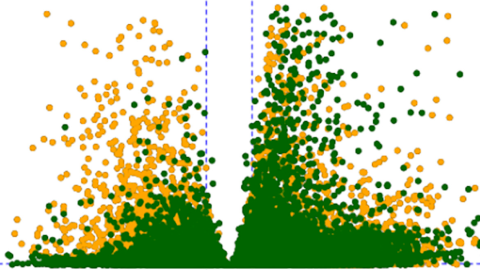New database measures gene activity in bacteria and their human hosts

A free-to-use database developed by researchers at the CRG and the UAB can help researchers and clinical experts to quickly detect the defensive genes that are triggered or evaded by multiple types of disease-causing bacteria, furthering the development of new types of antibiotics.
06/11/2020
The database, called DualSeqDB, can also be used to detect whether different types of bacteria use similar genes to infect humans and other mammals, highlighting promising therapeutic targets for the development of new antibiotics. It is described in a new research paper published in the journal Nucleic Acids Research.
“Pneumonia, tuberculosis and other curable diseases caused by bacteria are still a major problem today, and although many of these are easily treated using antibiotics where they are available, the bacteria continue to evolve and some are becoming increasingly resistant to our antibiotic repertoire”, says Benjamin Lang, postdoctoral researcher at the Centre for Genomic Regulation (CRG) and one of the creators of the database.
According to the authors, scientists and clinical experts can use the database to identify promising new drug targets by comparing how infection processes work across unrelated bacterial species. Researchers can also add their own datasets to DualSeqDB so that they can be more easily accessed and used by other researchers around the world.
“The public health implications of running out of antibiotic treatment options are severe, especially as multi-resistant strains of common pathogens are appearing in clinics worldwide,” says Dr. Lang. “Studying gene activity during infection processes using sequencing is one of the most highly cost-effective methods of discovering new drug targets.”
DualSeqDB was created by identifying and combining previously existing datasets. Using a well-defined pipeline, the teams standardized the gene expression data from different sources so that it was directly comparable.
“To our knowledge, we have created the first database that contains information about how pathogens and their natural hosts simultaneously change their gene expression during infection", says Javier Macho Rendón, predoctoral researcher at the Universitat Autònoma de Barcelona (UAB).
During infection, pathogens trigger the expression of unique genes that help them replicate within a host and ensure their survival. In turn, the host activates complex mechanisms to recognize and kill pathogens.
Researchers can track this arms race during the infection process using sequencing data from RNA transcripts simultaneously gathered from both bacteria and host. This ‘dual RNA-seq’ allows researchers to identify new traits at a molecular level that would otherwise remain undetected.
DualSeqDB was created by Gian Tartaglia and Benjamin Lang at the Centre for Genomic Regulation (CRG) and Javier Macho Rendón, Marc Ramos Llorens and Marc Torrent at the Universitat Autonoma de Barcelona (UAB).
“Given the current momentum of sequencing technologies in research and clinics, we expect that our database will grow continuously and become a comprehensive repository that will help us in the fight against infectious diseases,” concludes Dr. Marc Torrent, Associate Professor at the Department of Biochemistry and Molecular Biology at the UAB.
Enllaç a la base de dades:
DualSeqDB
Research article:
Javier Macho Rendón, Benjamin Lang, Marc Ramos Llorens, Gian Gaetano Tartaglia, Marc Torrent Burgas, DualSeqDB: the host–pathogen dual RNA sequencing database for infection processes. Nucleic Acids Research. https://doi.org/10.1093/nar/gkaa890